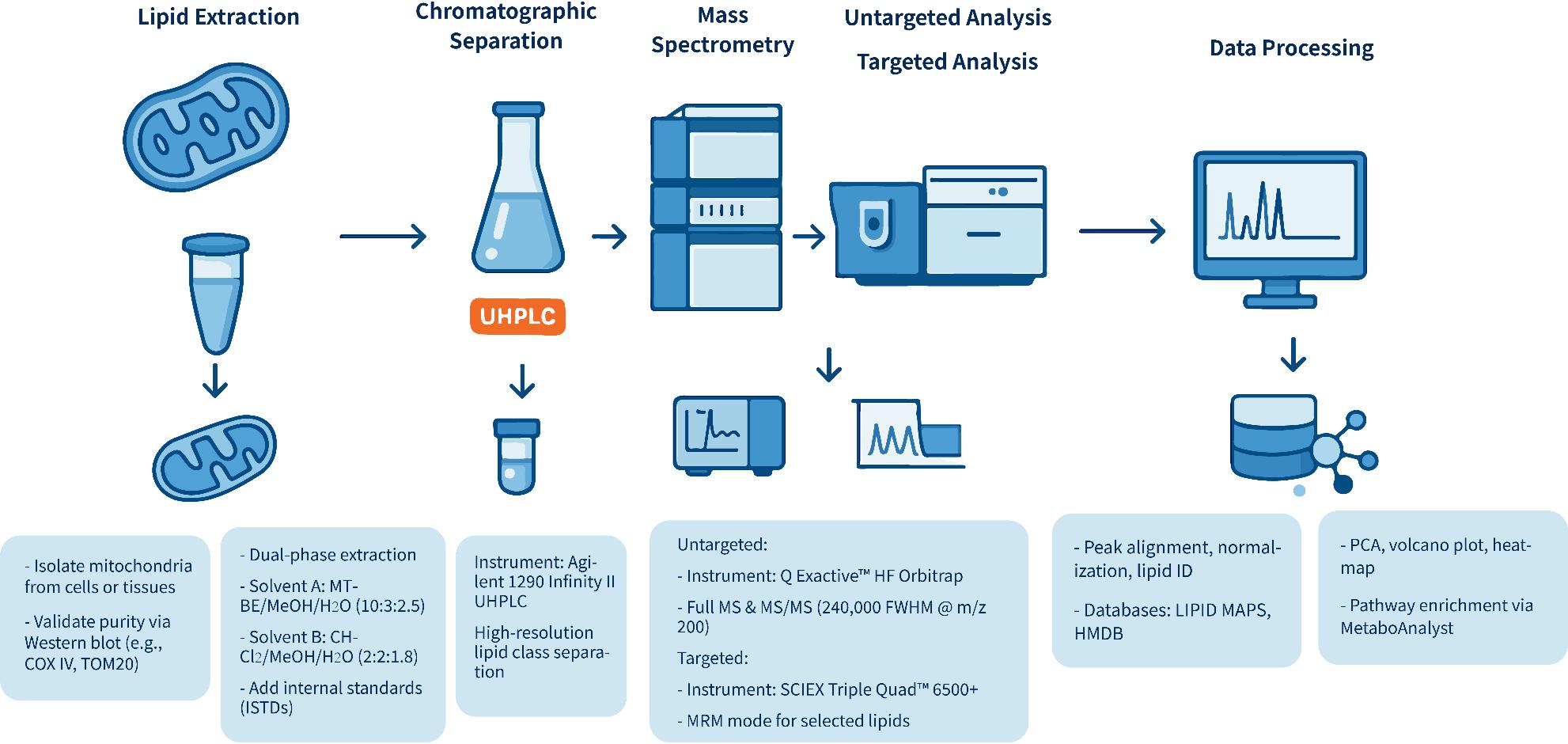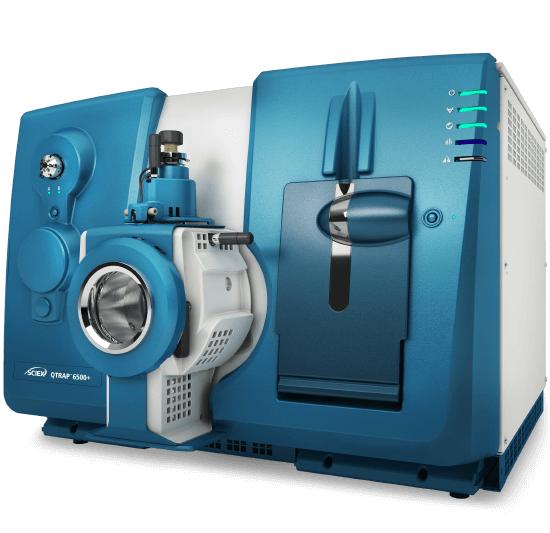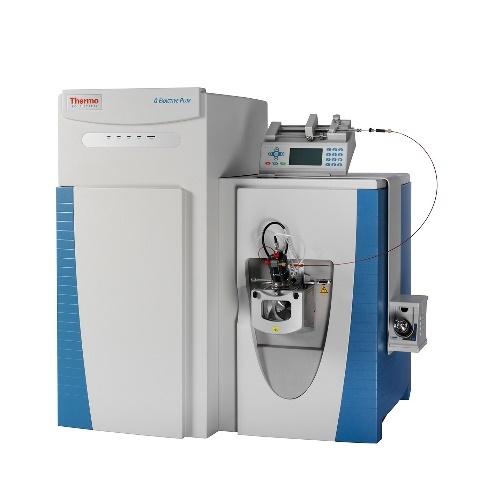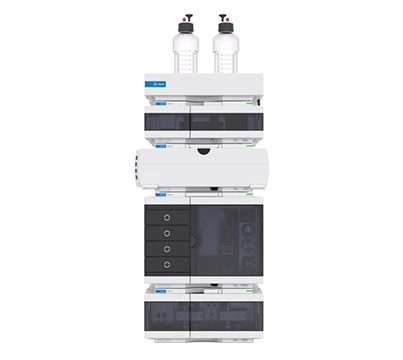Quantitative Profiling of Mitochondrial Lipid Classes
Absolute and relative quantification of key mitochondrial lipid species (e.g., CL, PE, PG, PC, LPC) via internal standard-based LC-MS/MS.
Our services have earned the trust of companies, schools, and organizations globally, and we remain dedicated to maintaining that trust.
Mitochondria, the central hubs of energy production and metabolic regulation, are deeply reliant on their lipid environment for structural integrity and functional efficacy. Lipid metabolism within mitochondria is a highly regulated process that underpins bioenergetic pathways, membrane dynamics, signaling cascades, and apoptotic processes.
Understanding mitochondrial lipid composition and metabolism is fundamental to:
Our service offers unmatched analytical depth and specificity across mitochondrial lipid classes, ensuring researchers gain mechanistic clarity from high-precision data.
Creative Proteomics provides a comprehensive suite of service items tailored to dissect the complexity of mitochondrial lipid metabolism with high specificity and reproducibility. Each module is designed to target key lipid classes, metabolic intermediates, and dynamic processes involved in mitochondrial lipid homeostasis.

Quantitative Profiling of Mitochondrial Lipid Classes
Absolute and relative quantification of key mitochondrial lipid species (e.g., CL, PE, PG, PC, LPC) via internal standard-based LC-MS/MS.

Mitochondrial Fatty Acid β-Oxidation Intermediate Analysis
Measurement of acyl-carnitines and β-oxidation intermediates to assess mitochondrial energy metabolism using targeted MRM analysis.

Cardiolipin Remodeling Assessment
High-resolution Q-TOF and LIPID MAPS® database integration enable identification of oxidized lipids (e.g., 4-HNE), acetylated/glycosylated phospholipids, and branched-chain fatty acids, elucidating roles in oxidative stress and signaling pathways.

Reactive Lipid Species Quantification
Sensitive detection of lipid peroxidation byproducts such as 4-HNE and MDA—biomarkers of mitochondrial oxidative stress.

Isotope Tracer-Based Lipid Metabolism Flux Analysis
Use of ¹³C or ²H-labeled substrates to trace lipid synthesis, degradation, and turnover rates within mitochondrial pathways.

Subcellular Lipid Enrichment
Isolation of mitochondrial fractions followed by lipidomics to ensure subcellular specificity and exclude cytosolic interference.

Lipid Pathway Enrichment and Bioinformatics Analysis
Bioinformatic analysis including PCA, volcano plots, KEGG/LIPID MAPS pathway mapping, and metabolite set enrichment.

Custom Lipid Panel Development
Tailored method development for detection of niche or novel mitochondrial lipids based on your specific project goals.
| Lipid/Metabolite Class | Representative Molecules | Associated Metabolic Pathways |
|---|---|---|
| Cardiolipins (CL) | CL(72:8), CL(70:5), CL(68:4) | Mitochondrial membrane integrity, cardiolipin remodeling |
| Monolysocardiolipins (MLCL) | MLCL(54:4), MLCL(56:3) | Tafazzin-mediated CL remodeling, Barth syndrome pathway |
| Phosphatidylethanolamines (PE) | PE(38:6), PE(36:2), PE(40:4) | Phospholipid biosynthesis, mitochondrial fusion/fission |
| Phosphatidylglycerols (PG) | PG(36:2), PG(38:4) | CL precursor biosynthesis, mitochondrial phospholipid pool |
| Phosphatidylcholines (PC) | PC(34:1), PC(36:4), PC(40:6) | PC-to-PE conversion, mitochondrial lipid exchange |
| Lysophospholipids (LPC, LPE) | LPC(18:1), LPE(20:4) | Phospholipid turnover, membrane remodeling |
| Acylcarnitines | C2:0, C8:0, C16:0, C18:1 | Fatty acid β-oxidation, carnitine shuttle |
| Fatty Acids | Palmitate (C16:0), Oleate (C18:1), Linoleate (C18:2) | β-oxidation, phospholipid acyl chain pool |
| Lipid Peroxidation Products | 4-HNE, MDA, isoprostanes | Oxidative stress, mitochondrial membrane damage |
| Isoprenoids/Coenzymes | CoQ10 (ubiquinone), CoQ9 | Electron transport chain, ROS regulation |
| Glycerolipids | DAG(36:2), TAG(54:3) | Lipid storage, mitochondrial lipid trafficking |
| Sphingolipids | Ceramide, sphingosine, SM(d18:1/16:0) | Apoptotic signaling, mitochondrial outer membrane integrity |
| Mitochondrial Sterols | Cholesterol, 7-dehydrocholesterol | Membrane fluidity, steroid biosynthesis interface |


AB SCIEX 6500+ QTRAP (Figure from SCIEX)

Thermo Fisher Q Exactive (Figure from Thermo Fisher)

Agilent 1260 Infinity II HPLC (Figure from Agilent)
Raw Data Files: Complete LC-MS/MS datasets (Thermo .raw and SCIEX .wiff formats).
Processed Data Tables: Quantified lipid species with retention time, m/z, fold change, and statistical significance.
Lipid Identification Report: Matched IDs using LIPID MAPS and HMDB, including lipid class, fatty acyl composition, and adducts.
Internal Standard Normalization: Fully corrected intensity values for reliable comparisons.
Multivariate Statistical Outputs:
Pathway Enrichment Results: Mapped mitochondrial lipid-related pathways via KEGG or Reactome.
Graphical Summary: Custom plots highlighting key altered lipid species and pathways..
Interpretation Notes: Expert-curated biological insights based on your experimental context
Explore our Lipidomics Solutions brochure to learn more about our comprehensive lipidomics analysis platform.

| Sample Type | Minimum Amount Required | Notes |
|---|---|---|
| Cultured Cells | ≥ 1 × 10⁷ cells | Fresh or frozen; recommend gentle homogenization for mitochondrial purity |
| Tissue Samples | ≥ 50 mg | Flash frozen in liquid nitrogen; avoid freeze-thaw cycles |
| Isolated Mitochondria | ≥ 100 µg total mitochondrial protein | Purified by differential or density gradient centrifugation |
| Biofluids (e.g., plasma)* | ≥ 200 µL | *For studies involving mitochondrial-derived vesicles or indirect profiling |
| Storage Condition | –80°C | Ship on dry ice to preserve lipid integrity |
| Replicates | ≥ 3 biological replicates | Ensures statistical confidence and reproducibility |

Metabolic Research
Investigating mitochondrial lipid remodeling in energy metabolism and nutrient sensing.

Neuroscience
Exploring mitochondrial lipid dynamics in neurodegeneration and synaptic plasticity.

Aging Studies
Profiling lipid changes linked to mitochondrial dysfunction in age-associated decline.

Mitochondrial Bioenergetics
Evaluating lipid compositions that affect membrane potential and oxidative phosphorylation.

Toxicology
Assessing lipid peroxidation and mitochondrial damage in xenobiotic or drug exposure studies.

Cell Stress Response
Monitoring lipid alterations under oxidative stress, hypoxia, or nutrient deprivation.
Can I send samples that have already undergone mitochondrial isolation?
Yes. We accept both raw tissues/cells and pre-isolated mitochondrial fractions, provided you supply basic QC documentation (e.g., Western blot or protein concentration).
How do you ensure mitochondrial purity for accurate lipid profiling?
We use Western blot detection of mitochondrial markers (e.g., TOM20, COX IV) and cytosolic/membrane exclusion markers (e.g., GAPDH, calnexin) to confirm mitochondrial enrichment.
Can you analyze specific lipid classes only (e.g., cardiolipins)?
Absolutely. Upon request, we can tailor the analysis to focus on specific lipid categories or pathways and adjust quantification and method parameters accordingly.
How are the internal standards selected for normalization?
We use class-specific, isotopically labeled lipid standards to correct for extraction efficiency, ion suppression, and quantification accuracy across different lipid subclasses.
Is batch analysis possible for multiple sample groups or time points?
Yes. We support multi-group and longitudinal sample design, with consistent processing and batch-correction across all conditions.
What file formats will I receive for downstream analysis?
You'll receive processed Excel tables, raw instrument files (.raw or .wiff), statistical plots (.png/.pdf), and optional annotated pathway diagrams (.svg/.pdf).
Do you provide support for publication figures or formatting?
Yes. We offer graphical abstract design, figure formatting, and legend drafting tailored for journals in biology, metabolism, or lipidomics.
How stable are mitochondrial lipids during sample transport?
Lipid integrity is best preserved by snap-freezing samples in liquid nitrogen and shipping on dry ice. Avoid freeze-thaw cycles to prevent lipid degradation.
Can I combine mitochondrial lipidomics with proteomics or metabolomics?
Yes. We provide integrated mitochondrial omics platforms, allowing for coordinated lipid–protein–metabolite profiling from the same sample batch.
How long will it take to receive the results?
Turnaround time is typically 4–8 weeks, depending on sample number and analysis depth. Rush service is available upon request.

References
Services:
Resource:
Platform:
Online Inquiry
CONTACT US

